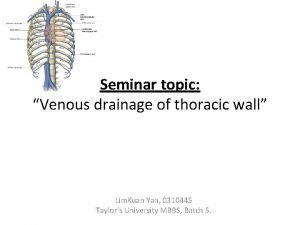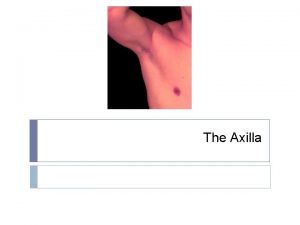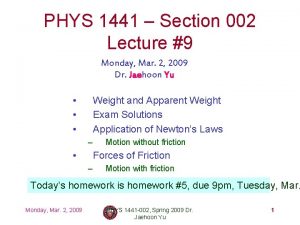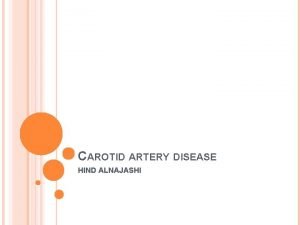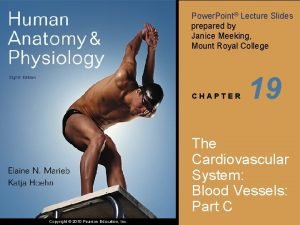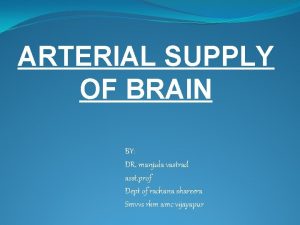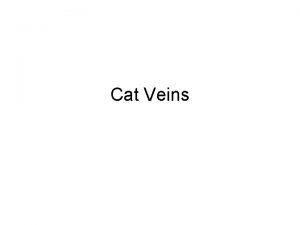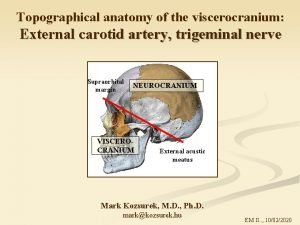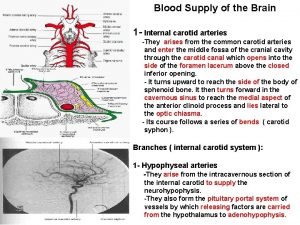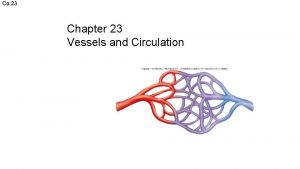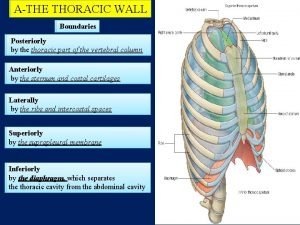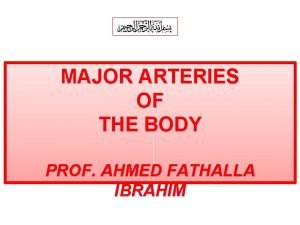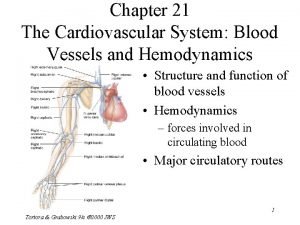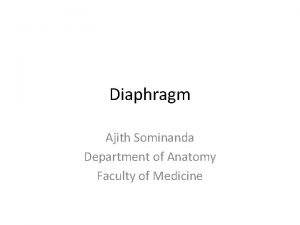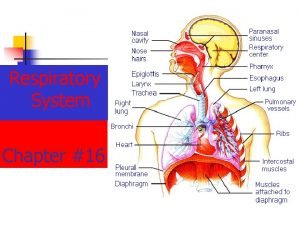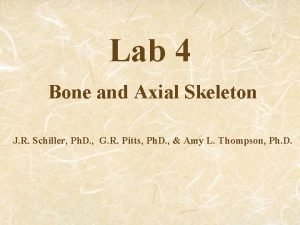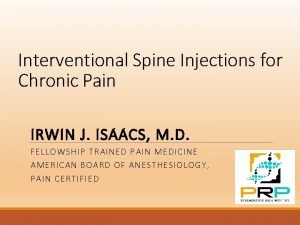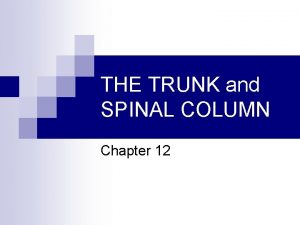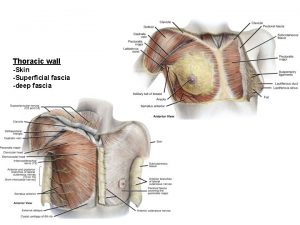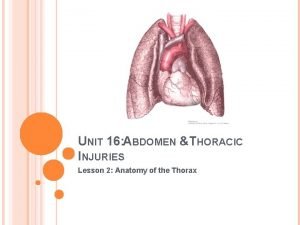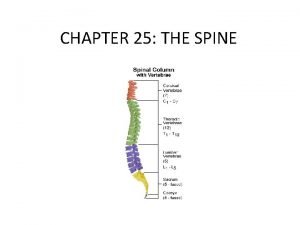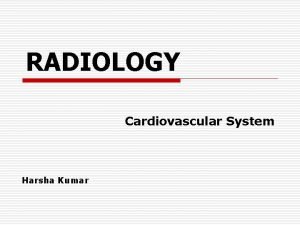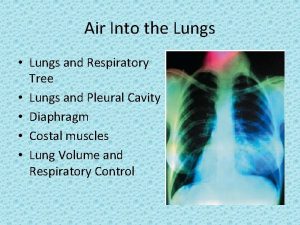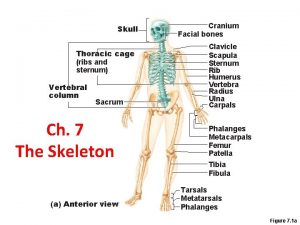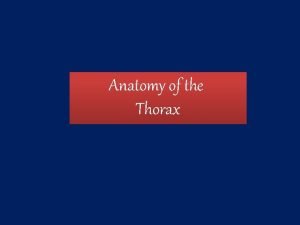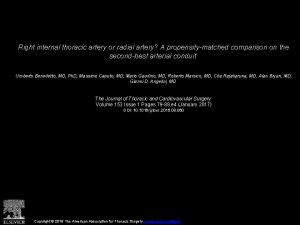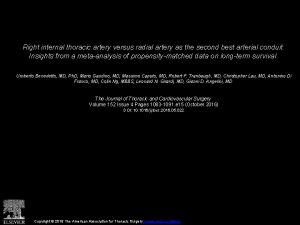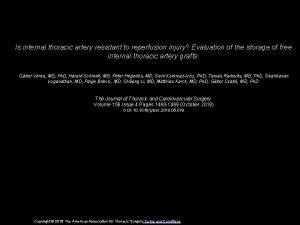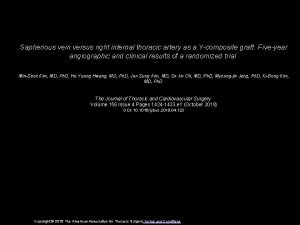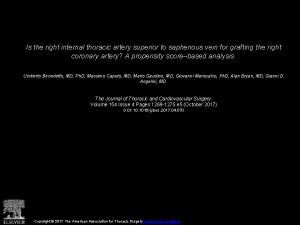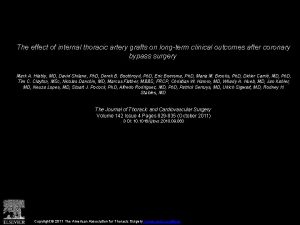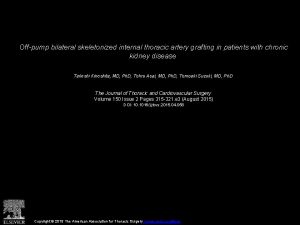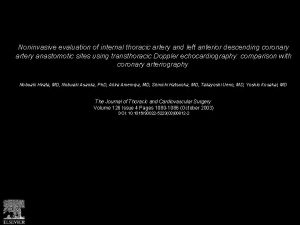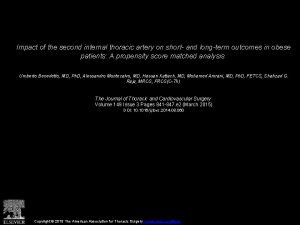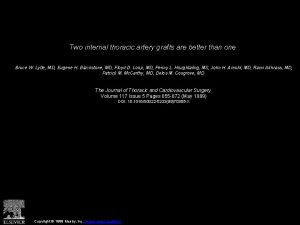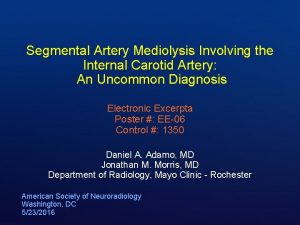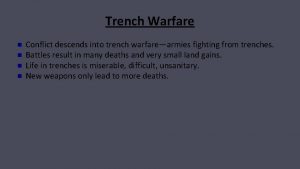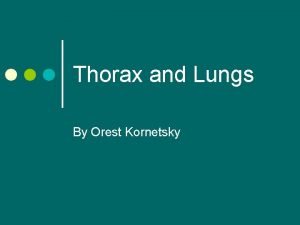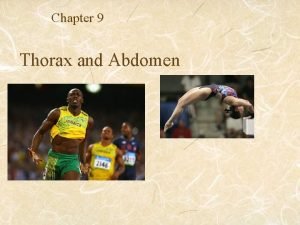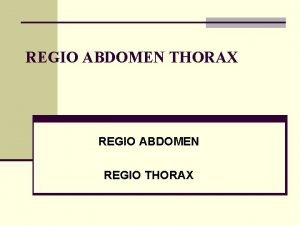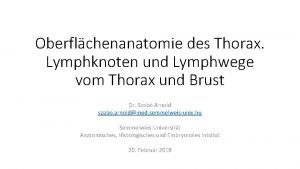Thorax Internal thoracic artery descends into thorax 1
















































- Slides: 48

Thorax

Internal thoracic artery descends into thorax 1. 2 cm lateral to edge of sternum, and ends at the sixth costal cartilage by dividing musculophrenic and superior epigastric arteries


Azygos vein n n Begins as continuation of right ascending lumbar vein Ascending along the right side of vertebral column Joins superior vena cava by aching above right lung root at level of T 4 to T 5 Receives right posterior intercostals and subcostal veins plus some of bronchial, esophageal and pericardial veins, and hemiazygos vein Tributaries – hemiazygos v. and accessory hemiazygos v. , which receive most left posterior intercostals vein and left bronchial veins

The lymphatic drainage of thorax The lymphatic drainage of thoracic wall n n n To axillary lymph nodes To parasternal lymph nodes (along internal thoracic vessels) To intercostals lymph nodes from deeper structures

lymph nodes of the thoracic contents lymph nodes of trachea, bronchi and lungs n n Pulmonary lymph nodes lie in the angles of bifurcation of branching lobar bronchi Bronchopulmonary hilar lymph nodes -lie in the hilus of the lung Tracheobronchial lymph nodes -situated above or below the bifurcation of trachea Paratracheal lymph nodes -along each side of the trachea

n Anterior mediastinal lymph node lies anterior to the large blood vessels of thoracic cavity and pericardium; the efferents unite with those of paratracheal lymph nodes, to form the right and left bronchomediastinal trunks. The left bronchomediastinal trunk terminates in thoracic duct, and right in the right lymphtic duct n Posterior mediastinal lymph nodes lie along the esophagus and thoracic aorta

Anterior branches of thoracic nerves n n n Intercostal nerves - (anterior rami of T 1 - T 11): runs forward inferiorly to intercostals vessels in costal groove of corresponding rib, between intercostals externi and intercostals interni; first six nerves are distributed within their intercostals space, lower five intercostals nerves leave anterior ends of their intercostals spaces to enter abdominal wall Subcostal nerve - (anterior ramus of T 12): follows inferior border of T 12 rib and passes into abdominal wall Distribution: distributed to intercostales and anterolateral abdominal muscles, skin of thoracic and abdominal wall, parietal pleura and peritoneum

The segmental innervation of anterior surface of trunk n n n T 2-sternal angle T 4- nipple T 6-xiphoid process T 8-costal arch T 10-umbilicus T 12-midpoint between umbilicus and symphysis pubis


Phrenic nerve n n n Descends over scalenus anterior to enter thorax Accompanied by pericardiophrenic vessels and passes anterior to lung roots between mediastinal pleura and pericardium to supply motor and sensory innervation to diaphragm Sensory fibers supply to pleurae, pericardium and peritoneum of diaphragm; usually right phrenic nerve may be distributed on live, gallbladder and biliary system.

Left vagus nerve n n n Enter thoracic inlet between left common carotid and left subclavian arteries, posterior to left brachiocephalic vein Crosses aortic arch where left recurrent laryngeal nerve branches off Passes posterior to left lung root Forms anterior esophageal plexus Forms anterior vagal trunk at esophageal hiatus where it leaves thorax and passes into abdominal cavity , then divides into anterior gastric and hepatic branches

Right vagus nerve n n n Enter thoracic inlet on right side of trachea Travels downward posterior to right brachiocephalic vein and superior vena cava Passes posterior to right lung root Forms posterior esophageal plexus Forms posterior vagal trunk at esophageal hiatus where it leaves thorax and passes into abdominal cavity, then divides into posterior gastric and celiac branches

Recurrent laryngeal nerves n n Right one hooks around right subclavian artery, left one hooks aortic arch Both ascend in tracheo-esophageal groove Nerves enter larynx posterior to cricothyroid joint, the nerve is now called inferior laryngeal nerve Innervations: laryngeal mucosa below fissure of glottis , all laryngeal muscles except cricothyroid Bronchial and esophageal branches

Thoracic sympathetic trunk n n Branches of sympathetic trunk to thoracic plexuses Greater splanchnic nerve - formed by preganglionic fibers from T 5~T 9 ganglia, and relay in celiac ganglion. Lesser splanchnic nerve - formed by preganglionic fibers from T 10~T 12 ganglia, and relay in aorticorenal ganglion. The postganglionic fibers supply the liver, spleen, kidney and alimentary tract as far as the left colic flexure.

Regional anatomy of thorax

Parts and regions of the thorax Boundaries n Superior - jugular notch, sternoclavicular joint, superior border of clavicle, acromion, spinous processes of C 7 n Inferior - xiphoid process, costal arch, 12 th and 11 th ribs, vertebra T 12 Regions n Thoracic wall n Thoracic cavity

Landmarks n Jugular notch corresponds with q n The 2 th thoracic vertebra in male, the 3 th thoracic vertebra in female Sternal angle connects 2 nd costal cartilage laterally corresponds with q q The lower border of 4 th thoracic vertebra The bifurcation of trachea in the adult The beginning of aortic arch which ends posteriorly at the same level The esophagus is crossed by the left main bronchus

n n Xiphoid process xiphisternal junction lies opposite the body of the 9 th thoracic vertebra Clavicle q q n n Ribs and intercostal spaces Costal arch q q n Inferior fossa of clavicle Coracoid process Infrasternal angle Xiphocostal angle Papillae

Thoracic wall n n Skin Superficial fascia q q q n Thoracoepigastric v. Supraclavicular n. Anterior and lateral cutaneous branches of intercostal n. Deep fascia

Lymphatic drainage of breast n n n Into pectoral ln. from lateral and central parts of breast Into apical and supraclavicular ln. from superior part of breast Into parasternal ln. from medial part of breast Into interpectoral ln. from deep part of breast The lymphatic capillaries of breast form an anastomosing network which is continuous across the midline with that of the opposite side and with that of the abdominal wall

Internal thoracic vessels n Internal thoracic a. &v. n Parasternal ln. Endothoracic fascia

The muscles of thorax Extrinsic muscles n n n Pectoralis major Pectoralis minor Serratus anterior Intrinsic muscles n n Intercostales externi Intercostales intimi Transverses thoracis

Intercostales externi n n Origin: lower border of riⅡ) Insertion: upper border of rib below origin Action: elevate ribs adding in forced inspiration Replaced anteriorly by external intercostals membrane. Intercostales interni n n Origin: upper border of rib Insertion: lower border of rib above origin Action: depress ribs forced expiration Replaced posteriorly by internal intercostals membrane.

Intercostal space Posterior intercostal v. Posterior intercostal a. Intercostal n.

Diaphragm Shape and position: dome-shaped between thorax and abdomen, consists of a peripheral muscular part and a central tendon Origin n n Sternal part: xiphoid process Costal part: lower six and costal cartilages Lumbar part: arises by two crura from upper 2 -3 lumbar vertebrae Insertion: central tendon Weak areas: triangular spaces without n n muscular tissue Lumbocostal triangle: between costal and lumbar parts. Sternocostal triangle: between costal and sternal parts.

Openings in the diaphragm n n n Aortic hiatus - lies anterior to the body of the 12 th thoracic vertebra between the crura. It transmits the aorta, thoracic duct Esophageal hiatus - for esophagus and vagus nerves at level of T 10. Vena cava foramen - for inferior vena cava, through central tendon at T 8 level T 8 T 10 T 12

Action: n n Contraction: the dome moving downward, increases the volume of thoracic cavity which results in inspiration, at the same time the intraabdominal pressure is increased assists in defecation, vomiting or child birth. Relaxation: the dome returns to the former position, reduces the volume to the thoracic cavity, resulting in expiration.

The Mediastinum Concept all of organs between the left and right mediastinal pleurae is called mediastinum. It extends from the sternum in front to the vertebral column behind, and from the thoracic inlet above to the diaphragm below.

Subdivisions of mediastinum Superior mediastinum Inferior mediastinum n n q q q Anterior mediastinum Middle mediastinum Posterior mediastinum

Left side of mediastnum Left subclavian a. Thoracic duct Left vagus n. Left recurrent n. Phrenic n. & pericardiacophrenic a. Root of lung Aortic arch Thoracic aorta Sympathetic trunk Pericardium Esophagus Greater splanchnic n

Right side of mediastnum Trachea Left vagus n. Arch of azygos v. Azygos v. Sympathetic trunk Esophagus Inferior vena cava Superior vena cava Phrenic n. & pericardiacophrenic a. Root of lung Pericardium

Superior mediastinum Locating - from inlet of thorax to plane extending from level of sternal angle anteriorly to lower border of T 4 vertebra posterioly Contents n Superficial layer q q Thymus Three veins n n n Left brachiocephelic v. Right brachiocephelic v. Superior vena cava

n Middle layer q q q Aotic arch and its three branches Phrenic n. Vagus n.

n Posterior layer q q q Trachea Esophagus Thoracic duct

Relations of aortic arch n n Anteriorly and to the left pleura, lung phrenic n. , pericardiacophrenic vessels and vagus n. Posteriorly and to the right trachea, esophagus, left recurrent n. , thoracic duct, deep cardiac plexus Superiorly - its three branches, left brachiocephalic v. and thymus Inferiorly - pulmonary a. , arterial ligament, left recurrent n. , left principal bronchus and superficial cardiac plexus

Triangule of ductus arteriosus n n Bounded by phrenic n. , left vagus n. and left pulmonary a. Contents- arterial ligament , left recurrent n. and superficial cardiac plexuses

Inferior mediastinum Anterior mediastinum n n Location - posterior to body of sternum and attached costal cartilages, anterior to heart and pericardium Contents - fat, remnants of thymus gland, anterior mediastinal lymph nodes

Middle mediastinum n n Location - between anterior mediastinum and posterior mediastinum Contents: hart and pericardium, beginning or termination of great vessels, phrenic nerves, pericardiacophrenic vessels , lymph nodes,

Posterior mediastinum n n Location - posterior to heart and pericardium, anterior to vertebrae T 5 - T 12 Contents: esophagus, vagus n. , thoracic aorta, azygos system of veins, thoracic duct, thoracic sympathetic trunk, posterior mediastinal lymph nodes

Relations of esophagus n Anteriorly - trachea, bifurcation of trachea, left principal branchus, left recurrent n. , right pulmonary a. , anterior esophageal plexus, pericardium, left atrium, diaphragm

n Posteriorly - posterior esophageal plexus, thoracic aorta, thoracic duct, azygos v. , hemiazygos v. , accessory hemiazygos v. , right posterior intercostal v.

n n Left - left common carotid a. , left subclavian a. , aortic arch, thoracic aorta, superior part of thoracic duct Right - arch of azygos v.

Relations of thoracic aorta n n Anteriorly - left root of lung, pericardium and esophagus Posterior - hemiazygos v. , accessory hemiazygos v. , Right - azygos v. and thoracic duct Left - mediastinal pleura

Thoracic duct n n Begins in front of L 1 as a dilated sac, the cisterna chyli, which formed by joining of left and right lumbar trunks and intestinal trunk Enter thoracic cavity by passing through the aortic hiatus of the diaphragm and ascends along on the front of the vertebral column, between thoracic aorta and azygos vein Travels upward, veering to the left at the level of T 5 At the roof of the neck, it turns laterally and arches forwards and descends to enter the left venous angle

n n Just before termination, it receives the left jugular, subclavian and bronchomediastinal trunks Drains lymph from lower limbs, pelvic cavity, abdominal cavity, left side of thorax, and left side of the head, neck and left upper limb Right lymphatic duct n n n Formed by union of right jugular, subclavian, and bronchomediastinal trunks Ends by entering the right venous angle Receives lymph from right half of head, neck, thorax and right upper limb

Mediastinal spaces n n n Retrosternal space - lies beween sternum and endothoracic fascia Pretracheal space - lies within superior mediastinum, between trachea, bifurcation of trachea and aortic arch Retroesophagus space - lies within superior mediastinum, beween esophagus and endothoracic fascia

Thoracic aorta n n Continuation of aortic arch at lower border of T 4 Courses downward on left side of, then in front of vertebral column Passes through aortic hiatus of diaphragm at level of T 12 vertebra to enter abdominal cavity Main branches q Parietal branches n Nine pairs posterior intercostals arteries n One pair subcostal artery n For lower nine intercostals spaces and upper part of abdominal wall; superior phrenic arteries supply the superior surface of the diaphragm. q Visceral branches n Bronchial branches: one or two for each lung n Esophageal branches n Pericardial branches
 Thoracic
Thoracic Azgos vein
Azgos vein Axillary muscles
Axillary muscles Sma origin
Sma origin Tu m'as dit zachee descends de ton arbre
Tu m'as dit zachee descends de ton arbre Luc 19 1 10
Luc 19 1 10 A 65 kg woman descends in an elevator
A 65 kg woman descends in an elevator Warm water rises in a lake. cold water descends.
Warm water rises in a lake. cold water descends. Amourosis fugax
Amourosis fugax Maxillary artery branches
Maxillary artery branches Posterior auricular vein
Posterior auricular vein Basilar artery course
Basilar artery course Brachiocephalic vein cat
Brachiocephalic vein cat Lingual artery
Lingual artery What artery supplies the hippocampus
What artery supplies the hippocampus Internal iliac artery mnemonic
Internal iliac artery mnemonic The radial and ulnar veins merge to form the
The radial and ulnar veins merge to form the Neurogeen thoracic outlet syndroom
Neurogeen thoracic outlet syndroom Layers of chest wall
Layers of chest wall Ventral cavity
Ventral cavity Manubrium
Manubrium Brachial pulse
Brachial pulse Which of the following elevates the ribs?
Which of the following elevates the ribs? Thoracic duct
Thoracic duct Latissimus dorsi innervation
Latissimus dorsi innervation Short tube that receives purified lymph
Short tube that receives purified lymph Thoracic aorta supplies blood to
Thoracic aorta supplies blood to Thoracic nerves
Thoracic nerves Accessory muscle
Accessory muscle Soft, spongy, cone-shaped organs in the thoracic cavity.
Soft, spongy, cone-shaped organs in the thoracic cavity. Lymphatic drainage abdomen
Lymphatic drainage abdomen Thoracic cage anterior view
Thoracic cage anterior view Rajesh shah thoracic surgeon
Rajesh shah thoracic surgeon Posterior mediastinum
Posterior mediastinum Basic anatomy terminology
Basic anatomy terminology Lumbar vertebrae characteristics
Lumbar vertebrae characteristics Chronic pain management irwin
Chronic pain management irwin False vertebrae
False vertebrae Deep fascia of thorax
Deep fascia of thorax Thoracic cavity
Thoracic cavity Muscles of thoracic spine
Muscles of thoracic spine Thoracic vertebrae not labeled
Thoracic vertebrae not labeled Thoracic membranes
Thoracic membranes Atheromatous thoracic aorta
Atheromatous thoracic aorta Dorsal cavity diagram
Dorsal cavity diagram Volume of thoracic cavity
Volume of thoracic cavity Right temporal bone
Right temporal bone Thoracic outlet wedge pillow
Thoracic outlet wedge pillow Fascia of thorax
Fascia of thorax

